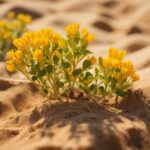Japanese Maples, with their elegant foliage and captivating colors, are a favorite among garden enthusiasts. However, to truly let these trees flourish, it’s crucial to understand the best soil for Japanese Maple.
This guide dives deep into the soil requirements of these beautiful trees, ensuring they not only survive but thrive in your garden.
Key Insights:
- Drainage is Crucial: Japanese Maples dislike “wet feet”, making proper drainage essential.
- Soil Types: These trees can adapt to both sandy and clay soils.
- Amendments: Often, native soil without excessive amendments is best.
- Container Planting: A mix of pine bark, peat, and perlite is recommended.
- Avoid High Nitrogen: Soils rich in nitrogen can be detrimental.
[toc]
Understanding the Needs of Japanese Maples
Japanese Maples are not just another tree; they are a statement. Their vibrant colors and unique leaf structures make them stand out. But beneath those fiery reds and calming greens lies a root system that’s particular about its home. Let’s delve into what these roots truly desire.
The Importance of Drainage
Imagine wearing wet socks all day. Uncomfortable, right? That’s how Japanese Maples feel with wet feet. These trees despise waterlogged conditions. If your garden tends to retain water, consider these steps:
- Raised Beds: Elevate the planting area using more soil, ensuring the roots stay above waterlogged zones.
- Check Soil Consistency: If water doesn’t drain quickly after a downpour, you might have a drainage issue.
- Avoid Low-Lying Areas: These spots tend to collect water, making them unsuitable for Japanese Maples.
Soil Types and Amendments
Contrary to popular belief, Japanese Maples aren’t too fussy about soil types. Whether you have sandy soils reminiscent of beach locales or heavy clay soils that can be molded like pottery, these trees can adapt. However, there’s a catch.
While they’re adaptable, introducing too many amendments can hinder their growth. Think of it as over-accessorizing an already stunning outfit. Sometimes, less is more. If your soil has decent drainage and isn’t as hard as a brick, there’s no need for major amendments. Your native soil, rich in micronutrients, often provides the best environment for these trees.
Ideal Soil Mixes for Japanese Maples
Planting trees in containers offers flexibility. You can move them around, ensuring they get optimal sunlight, or even bring them indoors during harsh conditions. But what soil mix works best for container-planted Japanese Maples?
Planting in Containers
At Mr. Maple, a renowned nursery, they swear by a mix that’s light and fluffy. This mix ensures optimal drainage, which is crucial for container plants. Here’s their recommended mix:
- 80% Pine Bark: Provides structure and aeration.
- 15% Peat: Retains just the right amount of moisture.
- 5% Perlite: Further enhances drainage.
Additionally, they sprinkle in a product called Micro Max, which introduces 32 essential micronutrients.
What to Avoid in Your Soil Mix
Nitrogen is essential for plants, but in excess, it can be a Japanese Maple’s nemesis. High-nitrogen soils, especially those with cow manure or heavy fertilizers, can cause more harm than good. They might keep the tree too active during winter, leading to potential damage. Remember, moderation is key.
The Significance of Soil to Tree Health
A tree’s health is often mirrored in its roots. Just as a strong foundation is vital for a building, healthy roots are essential for a tree. The soil, acting as this foundation, is pivotal in ensuring the tree’s overall health.
Japanese Maples, with their intricate root systems, are particularly sensitive to their soil environment. Good drainage not only prevents “wet feet” but also promotes robust root growth. Healthy roots can efficiently absorb nutrients, ensuring the tree remains vibrant and disease-free.
FAQs
Why is drainage so crucial for Japanese Maples?
Drainage is paramount for Japanese Maples because they dislike waterlogged conditions. Proper drainage ensures that the roots don’t remain submerged in water, preventing root rot and other related diseases.
Can I use store-bought soil mixes for my Japanese Maple?
Yes, store-bought soil mixes can be used, but it’s essential to ensure they provide good drainage. Some mixes, like MiracleGro, have been successful for many gardeners. However, for optimal results, consider adding pine bark, peat, and perlite to enhance drainage.
When is the best time to fertilize my Japanese Maple?
Spring is the ideal time to fertilize Japanese Maples, just as they break dormancy. Avoid fertilizing in the fall, as this can keep the tree active during winter, potentially leading to damage.
How to propagate a Japanese maple?
Japanese maples can be propagated through softwood cuttings, grafting, or seeds. The most common method is grafting onto rootstock.
How fast do Japanese maples grow?
Japanese maples have a moderate growth rate, typically 12-24 inches yearly.
How to plant a Japanese maple?
Choose a location with dappled sunlight, dig a hole twice the size of the root ball, place the tree, ensuring the top of the root ball is level with the ground, and backfill with soil and water thoroughly.
How big do Japanese maples get?
Depending on the variety, Japanese maples can range from 6-25 feet in height and 6-20 feet in width.
Conclusion
Choosing the best soil for Japanese Maple is more than just a gardening task; it’s an investment in the tree’s future. By understanding the tree’s needs, from drainage to soil type, you can ensure your Japanese Maple survives and thrives. Remember, the right soil mix, timely fertilization, and proper care are the keys to a vibrant and healthy Japanese Maple.
Sources / For More Information:
https://www.gardeningknowhow.com/ornamental/trees/japanese-maple/planting-japanese-maple-seeds.htm


